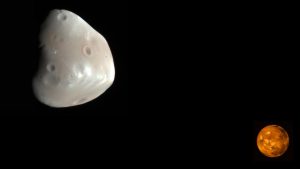
Using new dynamical models, scientists at the SETI Institute and Purdue University, led by Matija Ćuk, have found new evidence that Mars has had small rings in the past and will likely have them again in the future. This is all part of a cyclic ring theory for Mars. As a stellar astronomer, I’m going to choose to quote from the press release on this one, because I can’t find a better explanation than what they’ve already provided. “Mars’s inner moon, Phobos, is losing height as its tiny gravity is interacting with the looming Martian globe. Soon, in astronomical terms, Phobos’s orbit will drop too low, and Mars’s gravity will pull it apart to make a ring around the planet. Hesselbrock and Minton proposed that over billions of years, generations of Martian moons were destroyed into rings. Each time, the ring would then give rise to a new, smaller moon to repeat the cycle over again.
“This cyclic Martian moon theory has one crucial element that makes Deimos’s tilt possible: a newborn moon would move away from the ring and Mars. Which is in the opposite direction from the inward spiral Phobos is experiencing due to gravitational interactions with Mars. An outward-migrating moon just outside the rings can encounter a so-called orbital resonance, in which Deimos’s orbital period is three times that of the other moon.
“These orbital resonances are picky but predictable about the direction in which they are crossed. We can tell that only an outward-moving moon could have strongly affected Deimos, which means that Mars must have had a ring pushing the inner moon outward. Ćuk and collaborators deduce that this moon may have been 20 times as massive as Phobos, and may have been its “grandparent” existing just over 3 billion years ago, which was followed by two more ring-moon cycles, with the latest moon being Phobos.”
We don’t normally use that large a quote, but our hat is off to Press Release author Rebecca McDonald for that clear description. What is particularly nice about this result is that it has related compositional predictions, and if this theory is true, JAXA’s future Phobos lander will prove or disprove this published idea. You can read more in a future ApJL paper.




 Join the Crew!
Join the Crew!
 Escape Velocity Space News
Escape Velocity Space News
0 Comments